The Sawdust Factory Presents
Table Saw Modifications
A Bit of Customizing For A
Nicely Tailored Tool
Okay, So Here's The Deal: The following graphic representation
depicts the general essence of what I hauled home from Circle
Saw in Houston, Texas one fine February day in 2004: a Delta Contractor's Table Saw
complete with
extension table and mobile base. Man, are those wheels gonna make it really easy to
scoot this baby around as necessary or what? But wait, check out
those extension table support legs! Will somebody please explain how that's
supposed to work??
|
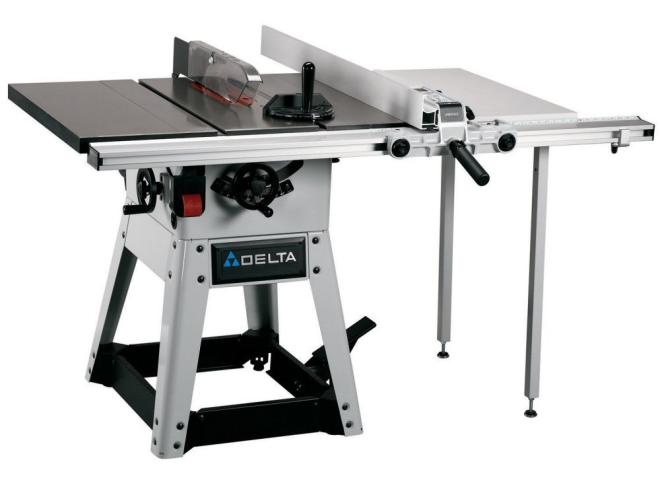
|
|
Trick question. There's no
way.
While the basic idea and implementation is solid enough, it's kind of
apparent that the engineering
department must have stepped out to lunch before putting the final polish
on this thing.
And so, always happy to lend a
helping hand,
we're going to finish it up for 'em in today's
exciting episode of The Sawdust Factory. |
|
Here's my machine after a little rework. The legs were converted into
braces going back to the table saw stand to achieve a lengthy list of
advantages, not the least of which is getting everything on
the mobile base with no compromises.
Was it a success? Well, the extension table
is strong enough to support my weight of 160 lbs, and the arrangement has been
working without a hitch since '04. I'd say that qualifies as fairly successful,
yep.
The mods were simple, easy, and cost
nothing, too.
|
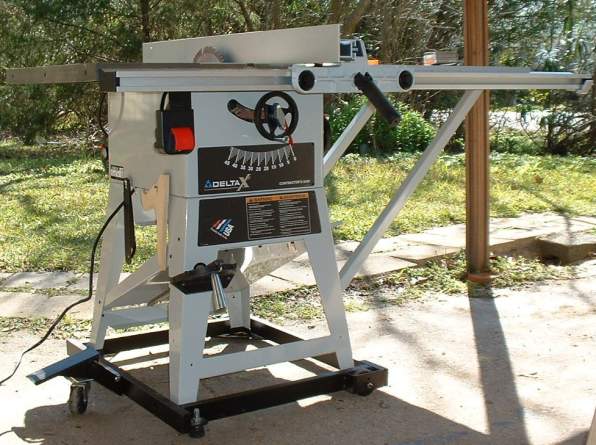 |
First
thing was to support the extension wing and remove the legs. Then hand-hold one of
the amputated legs here and there and everywhere to see what looks best. In no
time it was apparent it
would work as a (more or less) 45-degree-angle brace. Perfect!
|
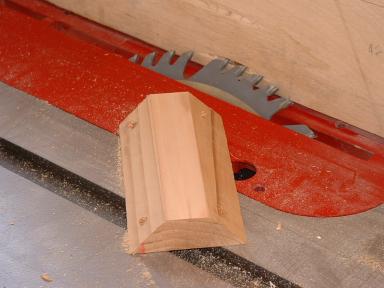
|
So I grabbed some scrap cedar and
cut a couple angled mounting blocks. |
|
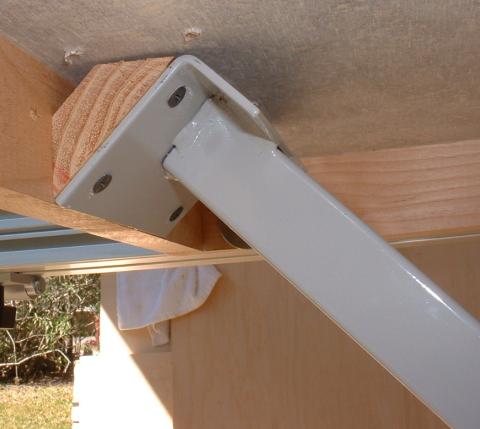
|
A couple holes and drywall screws later,
bango, 45-degree brace mounts, nothing to it.
Note the screw holes left behind from the
original leg location.
No need to sweat this part, there's very
little loading on the wood blocks or screws, and you could theoretically
do without 'em. Their main purpose in life is mostly to hold position, and prevent any slipping or sliding. Weight
of, and on,
the table is working in your favor here. |
|
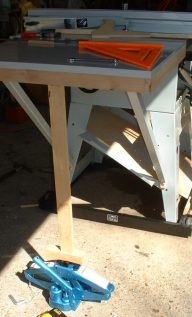
|
Next, to address the lower ends.
First order of business is to support the extension table in a controlled
manner. So out comes the hydraulic scissor jack I carry in my truck to
replace the darkly humorous anemic little bottle jack the factory supplied
ostensibly for changing tires, ha ha.
Crank the table up so that it's just a hair
above level, to allow for a bit of "relaxing" when you release
the lift pressure later. I removed
the threaded leveling feet from the leg bottoms, and with a flourish,
tossed them into a miscellaneous parts-n-pieces bin. They
offended me. |
|
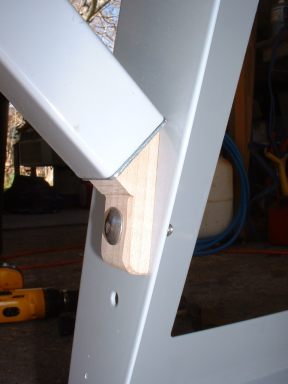
|
Then I cut and mounted these
fancy little stop blocks made from scrap maple, wedged the legs in place,
released the jack, and there ya go.
There's no need to be so
"artistic", a couple pieces of angle bracket would serve just as
well. But making little oddball parts like this is fun. The leg/braces are
not fastened to the stops, just very simply wedged in place.
And that pretty well takes care of that.
Next! |
Here are a few other
little odds and ends that really "make a house a home" for the table
saw.
| I like to "cram-fit" drywall or sheetmetal screws into undersize holes to make
"pegs" for hanging stuff I want to keep handy, like push sticks
and arbor wrenches. |
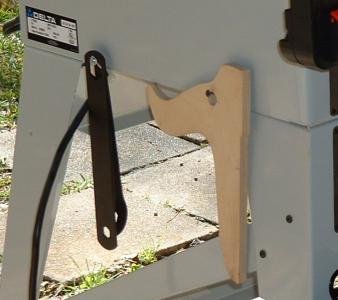 |
| Then add a
router table insert. If you have an extension table, gotta have a router
table insert, that's all there is to it.
This one is homemade from 1/8"
aluminum plate, but they're readily available commercially, just Google
"router table insert" and stand back. On the bottom end they're
very simple and inexpensive affairs, and from there spiral ever upward 'til
the sky's the limit. There's something for every taste.
|
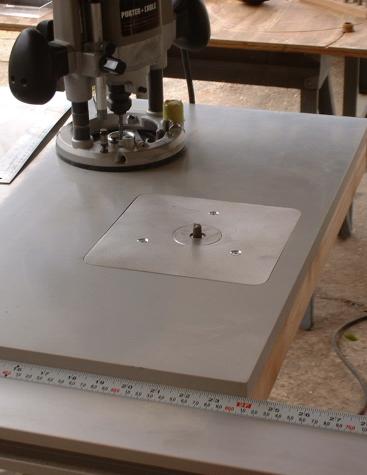 |
| I have added a bunch of other
"tips, tricks, and shop hints" for the table saw and other
woodworking tools on my boat building web site. Click
here for more table saw-specific subject matter, where I
talk about stuff like....
....using zero-clearance throat inserts on
both the table saw and band saw. They're easy to make - for some machines
anyway, perhaps something to think about when shopping for a new saw?
The magnetic feather board turns out to be
a clear winner. At ~$50 it isn't cheap BUT I'd replace it in instantly
if anything happened to it. And for that matter, I expect it to last forever.
|
 |
The table saw is arguably the
most important and versatile tool a woodworker can own and use. In order to be
safe, and get the most
out of it, your time is exceedingly well spent making special study of
it. There are tons of books on the subject, both in your local public library
and at booksellers everywhere, plus far too many web pages and sites to list,
all with nuggets of invaluable information. In my experience, no amount of fancy
and expensive aftermarket add-on accessories can come close to a little basic
knowledge for making you a productive and competent user.
I have worked in cabinet shops and
other commercial woodshop venues, and as an experienced hand with all ten
fingers fully intact, it occasionally falls to me to train shop noobies. Here are a few
observations from that experience:
Kickbacks:
Table saw kickbacks are caused by getting the workpiece misaligned with blade
and fence, pure and simple. If whatever you're cutting is held securely against the
fence , no kickbacks. It is absolutely essential that you
make it second nature and get religious about this. As with drifting astray from saintly ways, so it is
all too easy to complacently drift astray from the fence.
Better knock it off, or it will try to knock you off.
No, Wait a Sec:
Another type of table saw kickback happens when loose pieces lying near a spinning
blade gets bumped or sucked into it, and zzzing! Actually,
these should be called throwbacks. Whatever, keep the area around the blade clear,
and make a persistent habit to keep it clear whether the machine is running or not.
Follow Through:
Remember how you were taught to swing to about a foot past the ball for
maximum oomph? When feeding stock to blades or cutters, make it a habit to
continue the feed motion 'til well past the blade, which will help ensure
fingers and work pieces have cleared the danger zone and prevent throwbacks.
Blade Height:
The rule of thumb is raise blade just so bottom of gullets just show above stock
to be cut. Gullets are the low points between the teeth. This allows the blade
to clear sawdust from the kerf as it cuts. Secondary rule of thumb: the lower
the blade is set, the less chance of cutting fingers off. In some cases it is
well to set the blade higher or lower; when such is the case, just recognize
that it's a departure from the norm and raise suspicion height accordingly.
Always
wait for a machine to spin up fully before advancing material to it, or it to
the material as the case may be. Stand idle and do nothing but observe between
the time you power it up, and it is humming. Besides being good for the motor,
etc., if there's anything amiss this is a great and wonderful time to learn of
it. It takes one second, so do it.
GOLDEN RULE:
Always, always, always wait for the machine to come to a FULL AND COMPLETE STOP
after switch-off, before doing anything further. If I see a guy fiddling with a
machine in any way while it is still winding down after being turned off, I
cause him a man-made accident on the spot that he won't soon forget. It is the
dumbest thing in the world to not wait that extra one or two seconds, and this
is the one single thing I become most truly and authentically obnoxious
about.
Fun Fact of the Day:
The shaper is the leading accident machine in every shop cabinet type I have
ever worked in. Shapers are essentially super-sized router tables on
steroids. The most common mistake operators of routers and shapers make is
failing to take direction of rotation seriously, when in truth it means
everything.
And For Crying Out Loud:
wear safety glasses! Geeze.....
Back To The Sawdust Factory Table
of Contents
Email Kurt Maurer at NGC704@aol.com








